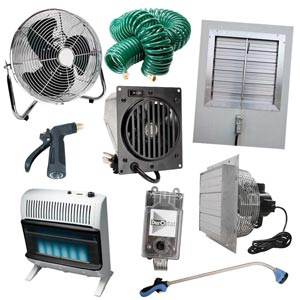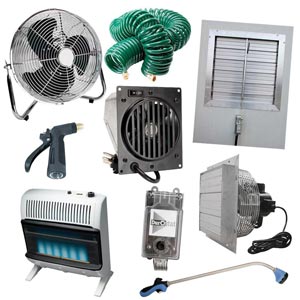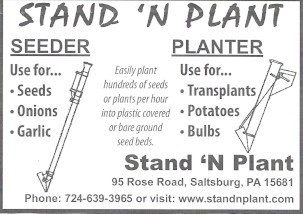Many factors are instrumental in the success of an indoor garden or small greenhouse. Much like the individual components of an engine, each of these contributing factors plays an important role in keeping a garden running smoothly. When one factor is not working, it can compromise the entire outcome of the garden. This is why it is so important for indoor horticulturists and greenhouse hobbyists to make sure every contributing factor is operating properly. Greenhouse maintenance is comparable to automobile maintenance; if done regularly, it will result in better performance and increased longevity. Each component of an indoor garden or greenhouse will, in some way, affect the final outcome of the garden. Although some factors will have more influence than others, it is important to establish a maintenance checklist so nothing is missed or overlooked. Most garden maintenance can be categorized under lighting, ventilation, nutrients, or general cleanliness.

Lighting
Light energy is the driving force behind all plant growth so it makes sense that this should be at the very top of the garden maintenance checklist. In other words, maintaining the highest lighting levels possible should be a priority for both indoor horticulturists and greenhouse growers.
Lighting for Indoor Horticulture
The lighting for an indoor garden is provided by an artificial light source. Again, that light source is the driving force behind all plant growth in an indoor garden. Although there are a few different lighting technologies used by indoor gardeners, the basics of garden maintenance are similar for all lighting systems. First and foremost, regularly cleaning the bulbs, reflectors, ballasts and any other components involved with the lighting system will help keep the light levels as high as possible and will also increase the longevity of the equipment. This, in turn, will equate to a higher return on investment for the horticulturist. In most cases, simply wiping down the surface of the equipment and removing the built up dirt, dust, or other gunk will help increase the light levels and the longevity of the lighting system.
Many horticulturists don’t realize how quickly a thin layer of dust can accumulate on the surface of the bulb or the reflector’s glass. This build up will cause a significant decrease in usable light energy for the plants. This is why indoor horticulturists should develop a routine of wiping down the lighting equipment about once a week. It is also extremely important to change bulbs in systems where it is applicable. High intensity discharge (HID) and fluorescent lighting systems need to have the bulbs changed annually (at the very least) to maintain the peak level of performance. Many gardeners experience diminished yields and don’t realize it’s due to the lighting system’s bulb(s). Regular bulb changes make all the difference with yield consistency.
Lighting for Greenhouse Hobbyists
The lighting in a greenhouse is different from an indoor garden because most greenhouses rely on natural sunlight instead of artificial lighting. That being said, the light energy available to plants in a greenhouse can still be significantly diminished if the surface of the greenhouse glazing becomes dirty or dusty. In order to maintain the highest possible light levels, greenhouse hobbyists should periodically wipe down both the inside and outside of the glazing. A clean greenhouse glazing will not only provide the plants within the greenhouse with the most light energy, it will also make the greenhouse look shiny and new.
Ventilation

Ventilation is another crucial factor for both indoor gardens and greenhouses. The ventilation system is responsible for bringing fresh air into the garden and exhausting stale air out of the garden. The ventilation system is the main component controlling the temperature and humidity in the garden. Unless the indoor garden or greenhouse has a CO2 injection system, the ventilation system will also be the main supply of CO2 for the plants. CO2 is needed for photosynthesis and without enough the plants will suffer.
Ventilation for Indoor Gardens
The maintenance of ventilation equipment in an indoor garden is multifaceted. This is because the ventilation equipment for an indoor garden serves many purposes. If setup correctly, a ventilation system should have the ability to control the temperature and humidity of the garden space. A daily check of the fans to make sure they are operating properly is an important part of garden maintenance. A broken fan can quickly cause a detrimental fluctuation in temperature that could be fatal to the plants.
It’s not a bad ideal to touch the outside of the fan motor to make sure it is not overheating or operating abnormally. In many cases, a fan’s motor will overheat before it stops working completely. A fan motor that is hot to the touch may be an indication of a failing fan. It is also a good idea to clean all fans (including oscillating fans) after every garden cycle. Cleaning the dirt, dust, and debris from ventilation equipment can help increase the equipment’s longevity. Ducting should also be inspected periodically to make sure all connections and fittings are snug and operating properly.
Filters are another important factor for indoor horticulture. Both intake and exhaust filters should be cleaned regularly or replaced to maintain the maximum air flow possible. Dirty filters can wreak havoc on fan motors because they create increased resistance. Even though ventilation fans are designed to handle resistance, bogged down fans are much more likely to have motor issues than fans operating at a lower resistance level.
In order to maintain a high level of performance, air filters and air conditioners should have the filters cleaned regularly. An air conditioner’s coolant levels should be checked and maintained on a regular basis to make sure they are operating at full capacity. Much like fans, bogged down air conditioners are much more likely to fail.
Ventilation for Greenhouses
Most greenhouse ventilation systems fall under two categories: passive or motorized. Passive ventilation systems rely on convection, while motorized ventilation systems rely on powered fans and/or louvers. For passive ventilation systems, a horticulturist should inspect the ventilation ports or louvers to make sure they are open and/or functioning properly. A stuck or plugged up louver can cause the temperature in a greenhouse to skyrocket. For greenhouses with ridge ventilation vents, a regular cleaning is the best way to prevent leaves, pine needles, or other debris from blocking the air flow. Greenhouses utilizing powered ventilation systems should follow maintenance procedures similar to those of an indoor garden (regular checking of fans, ducting, filters, etc.). A good cleaning of all ventilation equipment after each growing season is crucial. Not only will a deep cleaning of the ventilation equipment extend longevity, it will also reduce the likelihood of pathogens.
Nutrient and Fertilizer Storage
Nutrients and fertilizers don’t necessarily require maintenance, however, the way they are stored can affect a garden’s performance. Most nutrients and fertilizers should be stored in a cool, dark location. Sunlight and heat can damage or spoil nutrients and make them unsuitable for use.
General Cleanliness
In addition to all the equipment maintenance, there is also general cleaning to be done. A clean garden is a happy garden. Besides the pleasure of walking into a pristine plant paradise, there are some practical reasons to keep up with garden cleanliness. Regular cleaning of the garden space will do a lot to prevent potential pathogens from causing irreversible damage to the garden. For example, dead leaves or other dead plant material, such as old root balls, left in the garden space can provide a home to a wide variety of pathogens. It is only a matter of time before those pathogens make the move from the dead plant material to the healthy plants in the garden. By removing any unwanted organic material from the garden space, a grower automatically decreases the likelihood of pathogens.
At the very least, a good thorough cleaning should take place after every garden cycle. Planting containers, hydroponic equipment, and just about everything within the garden space will benefit from a regular cleaning. An occasional cleaning of the plants themselves is also a good idea. Much like the dirt or dust accumulating on the lighting system or the greenhouse glazing, a layer of dirt or dust on the surface of the leaves will decrease the plant’s accessibility to light. This is why some gardeners will periodically wipe down the plant’s leaves.
Maintaining the equipment in an indoor garden or greenhouse is one of the most important tasks a horticulturist can do to protect his or her investment. Not only does regular garden maintenance increase the longevity of the equipment, it also helps maintain optimal lighting, CO2, and nutrient levels for the plants themselves. Indoor gardens and greenhouses that provide the plants with these things are sure to have more consistent yields and a higher return on investment for the horticulturist.
The maintenance of an indoor garden and/or greenhouse mainly involves frequent inspections of the equipment to make sure all is operating properly. Both lighting and ventilation equipment benefit greatly from regular cleaning which is the bulk of the maintenance for the home hobbyist. Whether it is changing light bulbs in order to maintain high light levels or cleaning a filter to maintain maximum air flow, regular garden maintenance will keep an indoor garden or greenhouse operating as smoothly and efficiently as possible.
Eric Hopper resides in Michigan’s beautiful Upper Peninsula where he enjoys gardening and pursuing sustainability.
Related Articles
Artificial Light for the Greenhouse





Comment here